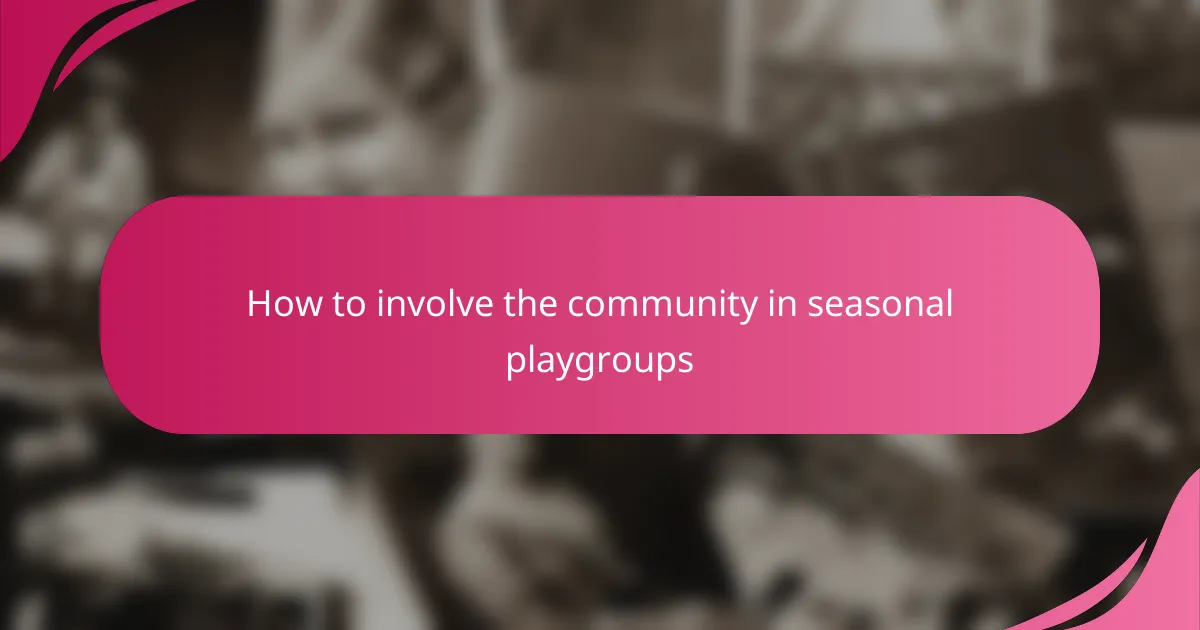Seasonal playgroups offer a wonderful opportunity to engage families in urban areas through themed activities that celebrate the changing seasons. By utilizing local resources and fostering community involvement, these playgroups can create memorable experiences that promote creativity, learning, and connection among participants. Incorporating themed materials and inviting community collaboration ensures that the activities resonate with families and enhance overall engagement.

How to plan seasonal playgroups in urban areas
Planning seasonal playgroups in urban areas involves organizing engaging activities that reflect the changing seasons while fostering community connections. Focus on local resources, themes, and partnerships to create memorable experiences for families.
Identify local community centers
Start by researching community centers in your urban area that offer space for playgroups. These centers often have facilities that can accommodate children and families, such as playrooms, outdoor areas, and restrooms.
Contact these centers to inquire about availability, rental fees, and any regulations they may have regarding events. Building a relationship with local centers can also lead to ongoing support for future activities.
Gather seasonal themes and materials
Select seasonal themes that resonate with families, such as autumn harvest, winter holidays, spring flowers, or summer fun. Each theme can guide the types of activities, decorations, and materials needed.
Collect materials like craft supplies, games, and seasonal decorations. Consider sourcing items from local stores or community donations to keep costs low while promoting local businesses.
Schedule events around holidays
Align your playgroup events with local holidays and seasonal celebrations to maximize participation. For example, plan a Halloween-themed playgroup in late October or a spring festival around Easter.
Check local calendars for public holidays and community events that might affect attendance. Scheduling your events when families are more likely to be free can enhance turnout and engagement.
Engage local businesses for sponsorship
Approach local businesses to sponsor your seasonal playgroups. Sponsorship can include financial support, donations of materials, or providing snacks for participants.
In return, offer to promote their business at your events, through signage or social media mentions. This partnership can strengthen community ties and provide businesses with positive visibility.
Utilize social media for promotion
Leverage social media platforms to promote your seasonal playgroups effectively. Create event pages on Facebook, share updates on Instagram, and use local community groups to spread the word.
Encourage participants to share their experiences online, which can help attract more families to future events. Consistent and engaging posts can build excitement and anticipation for each seasonal gathering.

What themed materials enhance playgroup experiences?
Themed materials can significantly enrich playgroup experiences by providing engaging and relevant activities that align with seasonal events. Incorporating these materials fosters creativity, learning, and community bonding among participants.
Craft supplies for seasonal activities
Craft supplies tailored to seasonal themes can spark children’s creativity and enhance their engagement during playgroup sessions. For instance, using autumn leaves for collages or snowflakes for winter decorations allows children to connect with the season while developing fine motor skills.
Consider stocking items like colored paper, glue, scissors, and seasonal embellishments such as stickers or stamps. A checklist of essential craft supplies might include:
- Construction paper in seasonal colors
- Natural materials like pinecones or acorns
- Markers and crayons for decoration
Books related to seasonal themes
Books that reflect seasonal themes can enhance the playgroup experience by providing storytelling opportunities that resonate with the current time of year. Reading seasonal stories helps children understand and appreciate the changes in nature and cultural celebrations.
Choose a variety of books that cater to different age groups and interests. For example, during the winter, you might select tales about holiday traditions, while spring could feature stories about growth and renewal. A few recommended titles include:
- “The Very Hungry Caterpillar” for spring
- “Bear Snores On” for winter
- “Leaf Man” for autumn
Outdoor equipment for seasonal games
Outdoor equipment designed for seasonal games encourages physical activity and social interaction among children. Depending on the season, the types of games and equipment can vary significantly, enhancing the playgroup’s overall experience.
In warmer months, consider items like frisbees, soccer balls, or water play toys. In contrast, winter may call for sleds, snowballs, or ice skates. Ensure the equipment is age-appropriate and safe. A simple inventory might include:
- Frisbees and balls for summer
- Sleds and snow toys for winter
- Jump ropes and hula hoops for spring

How to involve the community in seasonal playgroups
Involving the community in seasonal playgroups enhances engagement and ensures that activities resonate with local families. Effective strategies include inviting families to participate, collaborating with local institutions, and hosting meetings to gather feedback.
Invite local families to participate
Engaging local families is crucial for the success of seasonal playgroups. Start by promoting the playgroups through community bulletin boards, social media platforms, and local newsletters. Consider hosting an open house event where families can learn about the activities planned for the season.
To encourage participation, offer incentives such as free materials or refreshments. Creating a welcoming atmosphere will help families feel more inclined to join and contribute their ideas.
Collaborate with schools and libraries
Partnering with schools and libraries can significantly expand your reach. These institutions often have established connections with families and can help promote your seasonal playgroups through their networks. Consider organizing joint events, such as storytime sessions or craft workshops, that align with the seasonal theme.
Additionally, schools may have resources like space or volunteers that can support your activities. Be sure to communicate how the collaboration benefits both the playgroups and the educational institutions involved.
Host community meetings for feedback
Hosting community meetings is an effective way to gather feedback and involve families in the planning process. Schedule these meetings at convenient times, such as evenings or weekends, to maximize attendance. Use these sessions to discuss upcoming themes, activities, and any concerns families may have.
Encourage open dialogue and take notes on suggestions. This not only makes families feel valued but also helps tailor the playgroups to better meet community needs. Follow up with attendees after the meeting to keep them informed and engaged.

What are the benefits of seasonal playgroups?
Seasonal playgroups offer numerous advantages, including enhanced social interaction among children and strengthened community ties. These gatherings create an environment where families can connect while children engage in fun, themed activities that promote learning and development.
Fosters social skills in children
Seasonal playgroups provide children with opportunities to interact with peers, which is essential for developing social skills. Through structured activities and free play, kids learn to share, cooperate, and communicate effectively.
For example, during a fall-themed playgroup, children might participate in group games like pumpkin bowling or collaborative art projects. These activities encourage teamwork and help children navigate social dynamics in a supportive setting.
Encourages community bonding
These playgroups serve as a platform for families to connect, fostering a sense of community. Parents can meet others in their area, share resources, and build friendships, which enhances the overall support network for families.
Community bonding can be further strengthened through events like potlucks or local festivals, where families come together to celebrate seasonal themes. Such gatherings create lasting relationships and a sense of belonging among participants.
Promotes physical activity
Seasonal playgroups often include physical activities that encourage children to be active. Whether it’s running around during a summer picnic or participating in winter games, these events help combat sedentary lifestyles.
Incorporating movement into playgroup activities can be simple, such as setting up obstacle courses or organizing relay races. These activities not only promote fitness but also enhance motor skills and coordination in a fun, engaging way.

What criteria should be considered for selecting themes?
When selecting themes for seasonal playgroups, consider factors such as age appropriateness, alignment with local holidays, and the interests of the community. These criteria ensure that the themes resonate with participants and enhance engagement.
Age appropriateness of themes
Themes should be tailored to the developmental stages of the children involved. For younger children, simple and colorful themes like “Under the Sea” or “Farm Animals” can be engaging, while older children might enjoy more complex themes like “Space Exploration” or “Ancient Civilizations.”
Consider the cognitive and emotional maturity of the age group. Activities should be challenging yet achievable, fostering a sense of accomplishment without causing frustration.
Alignment with local holidays
Selecting themes that coincide with local holidays can enhance participation and excitement. For example, a “Harvest Festival” theme in the fall or a “Winter Wonderland” theme during the holiday season can create a festive atmosphere that resonates with families.
Research local customs and celebrations to ensure themes are culturally relevant and inclusive. This approach not only promotes community involvement but also enriches the playgroup experience by connecting children with their cultural heritage.


